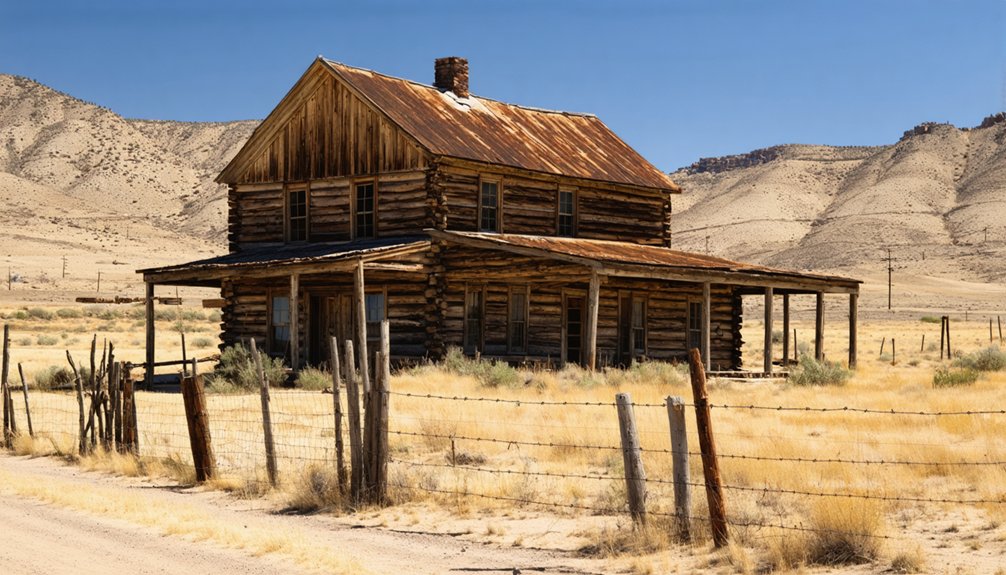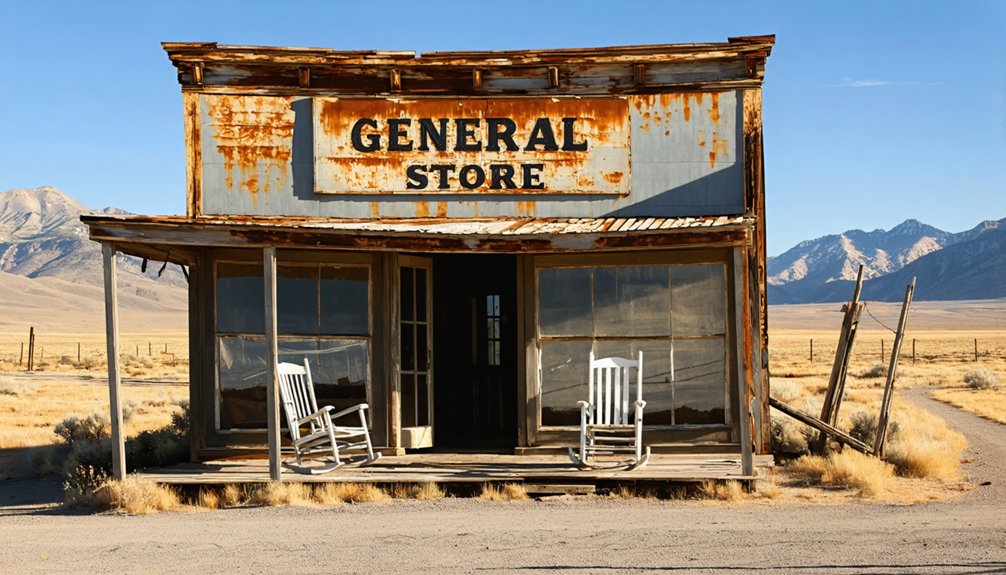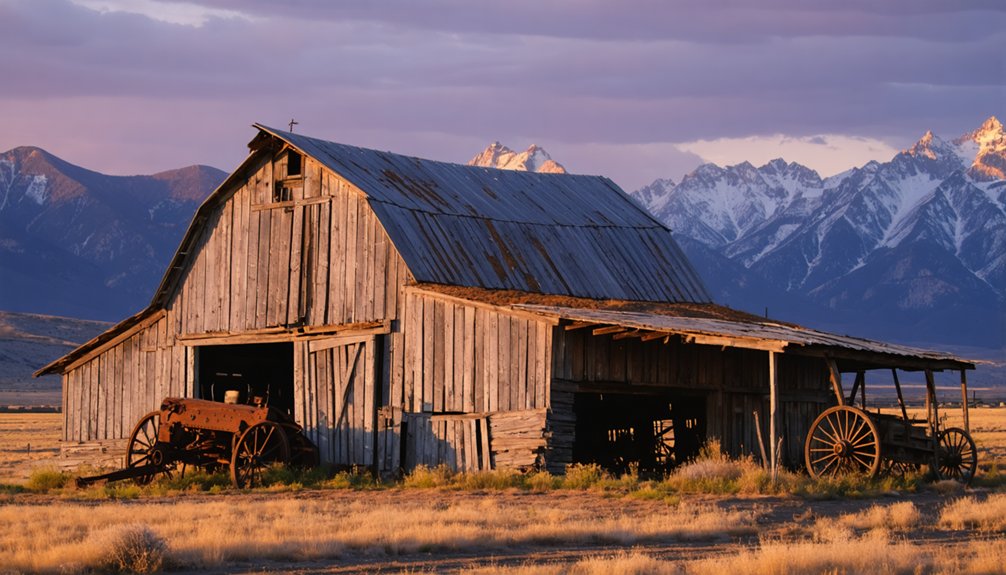You’ll find Three Creek, Idaho about 50 miles south of the Snake River, where Joe Scott established a ranching outpost in the 1870s. The settlement’s stone general store, run by Jim and Lizzie Duncan, became the heart of this frontier community that peaked at 32 residents in 1900. That same year, Butch Cassidy and his gang made an infamous visit, leaving double payment for supplies after a bank heist. Today, the weathered stone store stands as the last significant remnant of this intriguing ghost town.
Key Takeaways
- Three Creek, Idaho, established in the 1870s as a ranching outpost, is now a ghost town with only the stone general store remaining.
- The town’s population peaked at 32 residents in 1900 before declining due to exhausted mining resources and limited economic opportunities.
- The historic stone general store gained fame when Butch Cassidy’s gang visited in 1900 during their Winnemucca bank heist preparations.
- Most original wooden buildings were destroyed by fires, though the stone general store and charcoal kilns still stand as historical remnants.
- Located 50 miles south of Snake River, Three Creek is accessible by 4WD vehicle only, with no modern amenities or formal tours available.
The Birth of a Ranching Settlement
While many Idaho settlements emerged from mining booms, Three Creek began as a ranching outpost when Joe Scott established the first ranch there in the 1870s. Coming from Miles City, Montana, Scott branded his cattle with “71,” which became the area’s original name.
You’ll find Three Creek nestled in southeastern Owyhee County, about 50 miles south of the Snake River.
The ranching origins attracted settlers who could claim up to 320 acres through government land offers, provided they made improvements and secured water access. Settlement patterns show that families strategically chose locations near transportation routes and reliable water sources. Like many early Idaho ranchers, they faced conflicts with sheepherders as sheep production became increasingly profitable. The stone general store remains serve as a lasting reminder of the once-thriving community.
Life at Three Creek’s General Store
At Three Creek’s general store, you’d find Jim and Lizzie Duncan managing daily operations, providing essential supplies to local ranchers and miners in the remote Idaho community.
Similar to Metropolis’s early days when its population peaked at 700, the store served a vital role in supporting the area’s residents. The stone-built establishment served as more than just a trading post – it was a social hub where the sparse population of around 32 residents could gather and exchange news. Like the later Oakes Brothers Store, it became a cornerstone of community life for its region.
You might’ve encountered an unexpected visit in 1900 when Butch Cassidy, the Sundance Kid, and Will Carver forced proprietor Jim Duncan to load two packhorses with provisions for their getaway, though legend claims they later left double payment for their supplies.
Daily Operations and Trade
During the early 1900s, Jim and Lizzie Duncan’s stone-built general store served as Three Creek’s central lifeline, providing essential goods to a population of just 32 residents.
The store’s trade dynamics revolved around serving miners, ranchers, and travelers maneuvering the rugged terrain between Idaho and Nevada. You’d find basic provisions, tools, and daily necessities stocked on the shelves, vital for survival in this remote outpost.
Supply logistics relied heavily on pack horses, reflecting the challenging frontier conditions. With limited access to formal banking, you could often barter or receive credit for goods. The store’s unique construction used rocks from nearby creeks, giving it the durability to stand the test of time.
The store’s importance extended beyond commerce – it functioned as an informal communication hub where you’d exchange news and information, cementing its role as the community’s beating heart.
Cassidy’s Famous Supply Run
Three infamous outlaws – Butch Cassidy, the Sundance Kid, and Will Carver – made an unexpected midnight visit to Jim Duncan’s general store in Three Creek during mid-September 1900.
Cassidy’s motivations were clear: they needed supplies and packhorses for their upcoming Winnemucca bank heist. The gang woke Duncan at gunpoint, forcing him to fill their order while they planned their 200-mile journey from Power Springs.
This legendary encounter didn’t end there. After successfully robbing the First National Bank on September 19, the outlaws proved they’d their own code of honor.
They returned through Three Creek and left double payment for Duncan’s goods in a sack by the stone store.
Today, you’ll find the creek rock building still standing, a monument to one of the West’s most memorable outlaw supply runs.
The Day Butch Cassidy Came to Town
When Butch Cassidy, the Sundance Kid, and Will Carver arrived at Jim Duncan’s General Store in Three Creek, they roused the owner at gunpoint to secure provisions for their journey to Winnemucca.
This gang’s reputation preceded them, as they were known for executing one of Idaho’s most infamous heists when they stole $7,000 in Montpelier. The robbery was expertly executed when Elza Lay and Meeks joined Cassidy to target the Bank of Montpelier.
You’d have witnessed the outlaws loading two pack horses with supplies while Cassidy carefully calculated the total cost of their haul.
True to their word, they later returned under cover of darkness to leave payment in a sack by the store – not just matching the bill, but doubling it as promised.
The Supplies at Gunpoint
Amidst the late summer heat of August 13, 1896, Butch Cassidy and his gang orchestrated one of Idaho’s most notorious bank heists at the Bank of Montpelier.
Their gunpoint tactics were methodically planned, using a haying job as cover while they scouted escape routes. You’d have witnessed Cassidy and his men calmly walking into the bank unmasked, swiftly taking control of the situation as they ransacked the vault and cash registers. Assistant cashier Bud McIntosh endured a severe pistol-whipping from Cassidy. Bank teller A. N. MacKintosh would later positively identify Bob Meeks as lookout.
- Frank Caffey’s brave intervention was quickly thwarted at gunpoint
- The robbery lasted just five minutes, netting up to $7,000
- They’d prepared fresh horses strategically for their escape
- A deputy sheriff’s pursuit by penny-farthing bicycle proved futile
- The robbery aftermath left the town reeling from inadequate law enforcement resources
Outlaw’s Midnight Return
Racing north from Winnemucca, Nevada, Butch Cassidy and the Sundance Kid guided their horses through the Owyhee River valley after their latest bank heist, staying one step ahead of pursuing posses.
You’d have seen them swap fresh mounts near the CS Ranch, where Butch, true to outlaw folklore, kept a promise to a local boy about a horse even while dodging bullets.
Their midnight escapades led them past Elko, utilizing a network of safe houses and trusted allies.
You’d find Bob Meeks and other Wild Bunch members working under aliases at local ranches, while women like Maude Price secured supplies in nearby towns.
They’d cleverly used haying jobs as cover, coordinating horse relays and escape routes through Three Creek’s rugged terrain. The gang’s success often relied on their excellent horsemanship skills, particularly those of Bub Meeks.
The Double Payment Promise
Through the doors of Montpelier Bank on August 13, 1896, Butch Cassidy and his partners Elzy Lay and Bob Meeks strode in just before closing time, executing a meticulously planned heist that’d net them roughly $7,000.
After their escape, you’d find evidence of Cassidy’s unique approach to maintaining local goodwill – a sack of money and a signed note left on a store’s door, promising double payment for any trouble caused.
- Used cowboy jobs as cover while scouting escape routes
- Placed relay horses strategically along planned getaway paths
- Evaded an ill-equipped posse, including one deputy on a bicycle
- Changed horses at CS Ranch during their calculated escape
- Made personal promises, including one to a boy for a white Arabian horse
This calculated blend of criminality and honor became Cassidy’s trademark, earning him a Robin Hood-like reputation.
Surviving Structures and Lost Buildings

While many buildings in Three Creek have vanished over time, the Stone General Store stands as the town’s most prominent surviving structure. Built from locally quarried creek rocks, its stone preservation has withstood decades of harsh weather and neglect, showcasing the architectural significance of 1860s construction techniques.
You’ll find that fires in the late 1860s destroyed most of Three Creek’s original wooden buildings, tents, and mining facilities.
What hasn’t been claimed by flames or decay has often been buried under earth moved by dredging operations. The few remaining structures, like nearby charcoal kilns with their distinctive beehive shape, tell stories of the region’s mining heritage.
Time and industry have reshaped Three Creek’s landscape, yet surviving structures like the beehive kilns stand as monuments to its mining past.
These stone buildings were specifically chosen for commercial use, particularly when security was paramount for storing valuable goods.
Weather, Terrain, and Natural Surroundings
When visiting Three Creek today, you’ll encounter a rugged terrain marked by dramatic seasonal shifts, from warm 72°F summers to frigid winter temperatures that plunge to 11.5°F.
The area’s weather patterns follow the rhythm of high-desert Idaho, with south-southeast winds gusting up to 22 mph across creek-carved landscapes. Natural vegetation adapts to these extremes, thriving in summer warmth and lying dormant under winter’s snow cover.
- 4WD roads lead you through remote Owyhee County terrain dotted with rocky outcrops
- Thunderstorms roll through during late spring and summer, creating flash flood risks
- Creeks shape local microclimates, supporting unique riparian ecosystems
- Visibility ranges from 1 to 10 miles depending on precipitation
- Winter snow and summer showers maintain the area’s water-dependent plant life
The Decline of a Frontier Community

The rugged environment that shaped Three Creek’s character would ultimately play a role in its decline. Despite early community resilience, the town’s population began to dwindle from its peak of 32 residents in 1900. Economic factors, including the exhaustion of mining resources and fluctuating ranching markets, hit the remote settlement hard.
You’ll find that isolation played a significant part in Three Creek’s fate. Limited infrastructure and poor connectivity made it difficult for residents to sustain their way of life. As younger generations sought better opportunities and education in urban areas, the tight-knit community gradually unraveled.
While the Sparks, Harrell Co. brought prosperity in 1898, the lack of diversified economic opportunities and modern amenities eventually led most families to seek futures elsewhere, though their legacy lives on in the area’s rich frontier history.
Visiting the Ghost Town Today
Hidden away in southeastern Owyhee County, Three Creek stands as a tribute to Idaho’s frontier past, with the historic Stone General Store serving as its lone sentinel.
You’ll need a 4WD vehicle to navigate the unpaved roads leading to this remote ghost town, where Butch Cassidy once walked.
Summer offers the best visitor experience, as winter snow and spring mud can make access treacherous.
There aren’t any modern amenities here – you’re truly stepping back in time.
- Stone General Store remains the only significant structure, built from locally quarried rock
- No cell service or facilities – bring all necessary supplies
- Two-hour drive from Jarbidge, Nevada on rough roads
- Historical significance includes connections to infamous outlaws
- Best explored independently, as no formal tours or signage exist
Frequently Asked Questions
Were There Any Native American Settlements Near Three Creek Before Ranching Began?
You’ll find the Bannock and Paiute tribes lived in the broader region before ranching’s impact, but there’s no direct evidence of Native history at Three Creek’s specific location.
Did Three Creek Ever Have a School or Church Building?
Through the dusty lens of history, you won’t find documented evidence of a school or church building in Three Creek’s past – records and remains show only the stone general store’s lasting significance.
What Happened to Jim Duncan and His Wife After Three Creek Declined?
You won’t find conclusive records about Jim Duncan’s legacy or life after Three Creek’s decline. While their stone store remains as a ghost town landmark, the Duncans’ ultimate fate remains a mystery.
Were There Any Documented Murders or Significant Crimes in Three Creek?
You won’t find any documented murder mysteries or verified crime reports from Three Creek’s history. Historical records and ghost town registries don’t mention any major criminal activity in this quiet ranching community.
Did Any Other Famous Outlaws Besides Butch Cassidy Visit Three Creek?
You won’t find evidence of other famous outlaws visiting Three Creek besides Butch Cassidy, the Sundance Kid, and Will Carver. Historical records don’t show any other notorious criminals passing through.
References
- http://www.fs.usda.gov/r01/idahopanhandle/recreation/idaho-gold-and-ruby-mine-boulder-city-ghost-town
- https://www.youtube.com/watch?v=AQMyV46_T1I
- https://outerrealmz.com/the-amazing-ghost-towns-of-central-idaho/
- https://www.ghosttowns.com/states/id/threecreek.html
- https://owyhee.idgenweb.org/history/threecreek.html
- https://liteonline.com/eerie-video-shows-whats-left-of-one-of-idahos-most-unique-ghost-towns/
- https://www.familysearch.org/en/wiki/Three_Creek
- https://visitidaho.org/things-to-do/ghost-towns-mining-history/
- https://elmorecounty.org/history/
- https://history.idaho.gov/wp-content/uploads/2018/09/Cabin_Creek_Ranch_Historic_District_90000890.pdf



